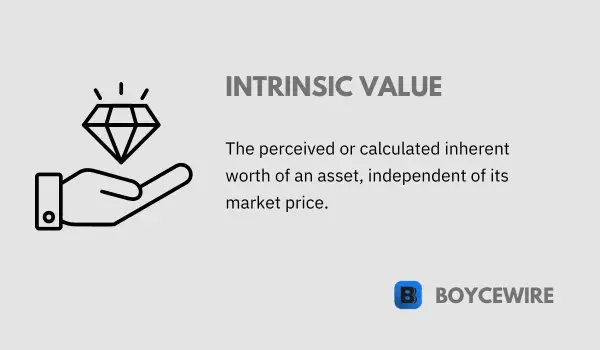Intrinsic Value: Definition, How to Calculate & Examples

What is Intrinsic Value?
Intrinsic value is a concept fundamental to the world of finance and investing, informing the decisions of investors, analysts, and financial professionals alike. It denotes the perceived or calculated value of an asset, investment, or a company, considering tangible and intangible factors, regardless of its current market price. The principle of intrinsic value asserts that an asset’s true worth may not always align with the price assigned to it in the marketplace. It’s a concept at the heart of value investing, an investment strategy famously utilized by the likes of Warren Buffet and Benjamin Graham.
Understanding intrinsic value is crucial because it allows investors to discern between an asset’s price and its worth, providing key insights that can help determine if an asset is overvalued or undervalued. This disparity between market price and value can provide lucrative opportunities for savvy investors who recognize this difference before the broader market does.
Key Points
- Intrinsic value refers to the inherent or true value of an asset or investment.
- It is determined based on the fundamental characteristics and potential future cash flows of the asset.
- Intrinsic value is subjective and can vary based on different valuation models and perspectives.
Understanding Intrinsic Value
Understanding intrinsic value involves distinguishing it from market value and recognizing the multitude of factors that determine an asset’s value.
- Difference between Intrinsic and Market Value While intrinsic value reflects what an asset is genuinely worth, the market value refers to the price at which an asset can be bought or sold in the marketplace. The price in the market is affected by the interaction between supply and demand and can change due to several factors, such as market sentiment, economic indicators, and news events. Conversely, the intrinsic worth is an assessment of an asset’s inherent value determined through a comprehensive evaluation of its fundamental aspects, encompassing both tangible and intangible elements. In an efficient market, the market price should align with the intrinsic worth, although disparities can arise, presenting potential investment possibilities.
- Factors Determining Intrinsic Value The determination of the true worth can take into account various factors, which may vary depending on the specific asset. When analyzing a stock, experts typically examine the company’s earnings, potential for growth, assets, liabilities, and the industry it belongs to. In the case of an option, the value would be based on the disparity between the current market price of the underlying asset and the strike price of the option.
In a broader context, the analysis of inherent worth often involves taking into account the overall economic conditions, interest rates, and even subjective elements such as the competency of a company’s leadership. Each of these aspects can impact the cash flows that investors anticipate receiving from the asset, forming the foundation for the determination of worth.
The challenge lies not just in identifying these factors but also in accurately quantifying them, a process often involving complex financial models, deep industry knowledge, and sometimes a measure of educated guesswork.
Calculating Intrinsic Value
Different approaches can be employed to calculate the intrinsic value of an asset. Here are some of the most commonly used methodologies:
- Discounted Cash Flow (DCF) Analysis The DCF method is one of the most widely recognized techniques for calculating the intrinsic value of a company. The concept is simple: it values an investment based on its projected future cash flows, discounted back to the present day. The discount rate typically used is the weighted average cost of capital (WACC) for a company, reflecting the cost of both equity and debt. However, accurately predicting future cash flows and choosing an appropriate discount rate can be challenging.
- Dividend Discount Model (DDM) For companies that consistently pay dividends, the Dividend Discount Model can be a viable method of determining intrinsic value. The DDM calculates the present value of future dividends that a company is expected to pay to its shareholders. Like DCF, the DDM also discounts future earnings to the present, but it focuses solely on dividend payments.
- Net Present Value (NPV) Analysis The Net Present Value method is often used for capital budgeting decisions. It’s a way to calculate the value of a series of future cash inflows and outflows. If the NPV of a project or investment is positive, it indicates that the present value of cash inflows is greater than the cost of the investment, suggesting that the project may be a profitable venture.
- Earnings Power Value (EPV) The EPV method is another approach to calculate the intrinsic value of a company. This approach values a business based on its “no-growth” cash flow—that is, the cash flow that a company is expected to generate if it never grows again. The method is sometimes preferred because of its simplicity and the fact that it doesn’t require making assumptions about a company’s growth prospects.
-
Role in Value Investing
Value investing is a strategy that involves buying stocks that appear to be trading for less than their intrinsic or book value. Value investors actively seek out stocks they believe the market has undervalued. They employ various methodologies to calculate the intrinsic value, such as those mentioned above, in the belief that the market will eventually recognize the true value of these stocks, leading to potential profits when this reevaluation occurs.
Investors like Warren Buffet, who follows the principles of his mentor Benjamin Graham, have popularized this approach. They’ve demonstrated that a disciplined strategy of buying undervalued assets can yield high returns over the long term. -
How Intrinsic Value Helps in Identifying Undervalued Stocks
By assessing an asset’s inherent worth, investors can establish a reference point to evaluate a company’s existing market price. If the calculated worth surpasses the current market price of a stock, it suggests that the stock is undervalued. This observation could potentially indicate an advantageous moment for value investors to consider purchasing the stock.
However, it’s essential to remember that calculating intrinsic value involves making assumptions about future performance and risk. These assumptions can be incorrect or may change due to unforeseen circumstances. Hence, intrinsic value should be considered as an estimate rather than a precise figure.
Furthermore, even if a stock seems to be undervalued, there is no assurance that its price will rise to align with its calculated inherent worth. Various factors such as market dynamics, shifts in the company’s performance, or alterations in the overall economic landscape can impact the stock’s price. Despite the presence of these uncertainties, many investors consider the concept of inherent worth to be a valuable tool in their investment decision-making journey. - Labour Theory of Value One of the earliest notions regarding inherent worth in economics is the labor theory of value, introduced by classical economists such as Adam Smith and David Ricardo. According to this theory, the inherent worth of a good or service is established by the quantity of socially necessary labor time needed for its production. Although this theory has been largely replaced in contemporary economic thought, it serves as a foundational element in the work of Karl Marx.
- Subjective Theory of Value In contrast to the labour theory of value, the subjective theory of value asserts that a good’s intrinsic value is not determined by any inherent property of the good, nor by the amount of labour necessary to produce the good, but instead by the importance an individual places on a good for the fulfillment of his/her wants. This is the basis for modern economics, where value is seen as subjective and varies from individual to individual.
- Intrinsic Value in Resource Allocation In economics, intrinsic value can also play a role in resource allocation. It can be argued that resources should be used in ways that maximize their intrinsic value. This might mean, for example, preserving areas of natural beauty rather than exploiting them for resources, due to the intrinsic value these areas provide beyond their potential market price.
-
Challenges and Limitations in Calculating Intrinsic Value
One of the primary concerns raised about calculations based on inherent worth is their reliance on assumptions about the future, which inherently involve uncertainty. For example, techniques such as DCF or DDM necessitate forecasts of future cash flows or dividends, and even slight adjustments to these forecasts can yield notably divergent estimations of worth.
Additionally, the choice of an appropriate discount rate can be subjective and can drastically affect the resulting intrinsic value. Real-world variables, such as inflation and interest rates, can change, leading to shifts in the discount rate over time.
Furthermore, estimations based on inherent worth may overlook intangible elements such as the caliber of a company’s leadership or the potential influence of emerging technologies on its future performance. -
Potential Misuses and Misinterpretations
Another concern raised is that the notion of inherent worth can be subject to misuse or misinterpretation. For example, investors may mistakenly view inherent worth as an exact or guaranteed price objective, disregarding the fact that it is an estimation derived from multiple variables and assumptions, which may turn out to be incorrect.
Additionally, the fact that a stock is trading below its estimated inherent worth does not automatically indicate that it is a favorable purchase. There could be legitimate reasons behind the lower market price, such as imminent risks that are not accounted for in the calculation of inherent worth.
Each of these methods provides a unique perspective on the intrinsic value of an asset, but they all share a common goal: to estimate the value of an asset based on its ability to generate returns or income in the future.
Intrinsic Value in Stock Market Investing
Intrinsic value plays a significant role in the stock market, particularly within the framework of value investing. Here’s how it works:
Intrinsic Value in Economics
In the field of economics, intrinsic value refers to the inherent worth of a good or service, determined by the resources used in its production, rather than its market price. While this concept is typically less quantifiable than in finance, it forms an essential part of economic theory.
While the concept of inherent worth finds distinct applications in economics as opposed to finance, it offers a valuable theoretical framework in both fields for comprehending the creation of value and the optimal utilization of resources. Nonetheless, due to the subjective nature of inherent worth in economics, it remains a complex concept that is frequently subject to debate.
Criticisms and Limitations of Intrinsic Value
While intrinsic value serves as a fundamental concept in finance and investing, it is not without its criticisms and limitations. Understanding these can help investors and analysts apply the concept more effectively and avoid potential pitfalls.
While these limitations and criticisms don’t invalidate the concept of intrinsic value, they underline the importance of using it as one tool among many in an investor’s toolkit, and not as an infallible guide to investment decisions. As with any financial model, understanding its limitations is crucial to its effective use.
Examples of Intrinsic Value
To understand this concept better, let’s walk through some illustrative examples of its calculation:
1. Intrinsic Value of a Stock
Let’s consider a company with the following characteristics: It’s expected to generate $1 million in cash flow next year, and that cash flow is expected to grow by 4% per year indefinitely. The company’s WACC, which we’ll use as our discount rate, is 8%. Using the Gordon Growth Model (a form of DCF), we calculate the intrinsic value as follows:
Value = Cash Flow / (Discount Rate – Cash Flow Growth Rate)
Value = $1,000,000 / (0.08 – 0.04) = $25,000,000
If this company had 1 million shares outstanding, the intrinsic value per share would be $25 ($25,000,000 / 1,000,000). If the stock’s current market price were $20, it might be considered undervalued.
2. Intrinsic Value of an Option
For a call option (the right to purchase a stock), the determined worth is calculated as the disparity between the current market price of the stock and the strike price of the option (if it is positive). Hence, if a call option has a strike price of $50, and the stock is presently trading at $60, the determined worth of the call option would be $10.
Note: This is a simplified example. Real-world intrinsic value calculations for options would also consider time value.
These examples demonstrate how estimations of inherent worth can contribute to investment choices. However, it is important to remember that these calculations rely on assumptions regarding future performance and risk. It is crucial to acknowledge the inherent uncertainty of these assumptions when utilizing estimates of inherent worth as guidance for investment decisions.
FAQs
Intrinsic value refers to the inherent or true value of an asset, independent of its market price.
Intrinsic value is determined based on the fundamental characteristics of the asset, such as its cash flow potential, earnings, growth prospects, and underlying assets.
Intrinsic value represents the true worth of an asset, while market value is the current price at which the asset is traded in the market.
Intrinsic value is subjective and can vary depending on different valuation models and individual perspectives.
About Paul
Paul Boyce is an economics editor with over 10 years experience in the industry. Currently working as a consultant within the financial services sector, Paul is the CEO and chief editor of BoyceWire. He has written publications for FEE, the Mises Institute, and many others.

Further Reading
 Cognitive Dissonance - Cognitive dissonance is the psychological discomfort experienced when a person holds conflicting beliefs or attitudes.
Cognitive Dissonance - Cognitive dissonance is the psychological discomfort experienced when a person holds conflicting beliefs or attitudes.  EBITDA: Definition, Pros, Cons & Example - EBITDA stands for Earnings Before Interest, Tax, Depreciation, and Amortization.
EBITDA: Definition, Pros, Cons & Example - EBITDA stands for Earnings Before Interest, Tax, Depreciation, and Amortization.  Embargo Definition and Examples - An embargo is a government-imposed restriction on trade or economic activity with a specific country or group of countries.
Embargo Definition and Examples - An embargo is a government-imposed restriction on trade or economic activity with a specific country or group of countries. 